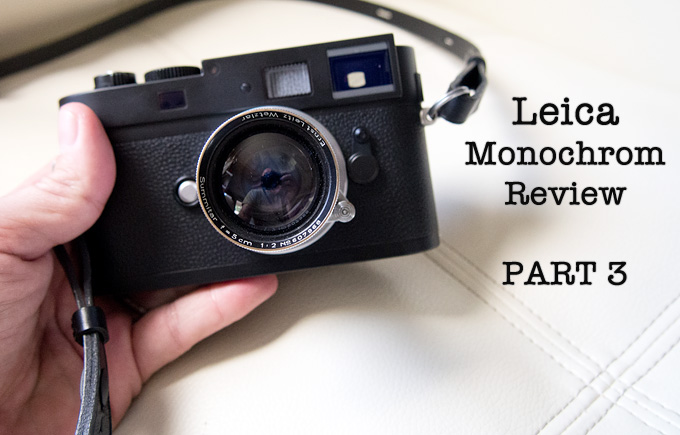
The Leica Monochrom – My final words and samples and comparisons…for now.
So here I am, a few weeks in with my Leica Monochrom and still loving the damn thing. I was hoping I would see it as a camera that is a gimmik..a joke..a camera that is no different from any other Leica M digital but that has not been the case. Yea, I love Leica. Always have. I have also criticized them when it was warranted and when they released sub-par products that was beaten by the competition at a much cheaper price.
[ad#Adsense Blog Sq Embed Image]
The Monochrom is a tricky beast. The price leaves it well out of reach for most yet there are so many photographers who lust for one. Others have the opinion that it is crap..an overpriced camera without features or…COLOR! But I see it as a unique one of a kind tool that does indeed beat the Leica M9 for tonality and high ISO capability.
“Little Man” – Leica Monochrom – 50 F/2 Summitar – cropped – Click it for larger version. BTW, this has not had any Photoshop work.
In case you missed them, you can see my previous entries in my ongoing Leica Monochrom review below:
Part 1: Understanding the Camera
Part 2: Low light, High ISO and using Filters on and off the camera
Part 2.5: More thoughts on the camera
GALLERY: The Leica Monochrom Gallery – New images added weekly
“Zombie Jake” – Monochrom with 35 1.4 – ISO 320 – You must click this to see the detail in the larger version!
–
The Monochrom is a real tool..for real photographers..for those who adore B&W photography
I have said this before but not everyone will understand it. Those who refuse to even think about spending this kind of money will instantly bash the Mono on that alone. Others will bash it because they want it but can not afford it and others will bash it because they will say their camera is just as good. Others will say “NOTHING will ever match film”, which is 100% true but why would I pay $8000 to match film? I personally feel what comes out of the Monochrom beats film in many ways. The ones who bash this camera are the photographers who do not get it, and therefore not the target market Leica was aiming at when they released the Monochrom.
The beautiful Zeiss Sonnar f/1.5 on the MM
–
and a $250 Canon 50 1.8 LTM
I have already stated that I feel the camera is overpriced but the reason for this is because it is indeed a “one of a kind” product. No one else makes a camera such as this and yes, there is a difference in the B&W quality between this camera and a Leica M9 converted file. Is it better? Well, not everyone will agree but I think so. In part 2.5 I posted three images. One from the M9 that was a converted B&W and two from the Mono. I saw the difference in tonality and I will show more below. But is it enough to fork over this kind of cash? No, not really.
What makes this camera worth it to many is because of what it is and that is PURITY. How can a digital camera be pure? By being a simple, old school, B&W only camera. That is how. It is just as pure as film and has capabilities that surpass film. Many film die hards will disagree and I am not bashing film because I also love film, I just do not shoot it these days due to cost and time.
“In Flight” – Monochrom with 50 1.5 Zeiss Sonnar – ISO 320
As I walk the street with my Monochrom I sit and think… What am I doing owning a $8000 Leica camera body when I am not in that upper income bracket that Leica is so marketing this camera to? Why should I own this beauty when there are other more deserving photographers who can make better use of it? Why do I NEED this camera? Then I think some more..and the answer is clear. Because you only live once and if I can say anything about life is that we all need to LIVE IT in a way that makes us happy. We do not get a 2nd chance, life is not a dress rehearsal. We are here and then we are gone and if this camera makes me a happy man then I deserve to have it and use it and adore it.
That is basically the attitude I have with all Leica gear. I certainly should not be spending cash on Leica lenses and cameras but at the same time I do not own anything else extravagant. So why not? 🙂
The fact is that I love the Monochrom. I have shot it all over the place and what I see coming from it are results in B&W that are “different from any other camera I have shot with and converted. It has a look and a feeling. It may not be everyone’s cup of tea, and truth be told..when you start shooting the camera it takes some getting used to. The 1st few weeks I always saw shots I wanted to shoot in color. Today when I go out with the Monochrom I do not see color. I see only in black and white.
“Fresh Pie” – Monochrom and 35 1.4 – direct from camera on a harsh bright AZ day
–
Compared to the Leica M9 – Tones
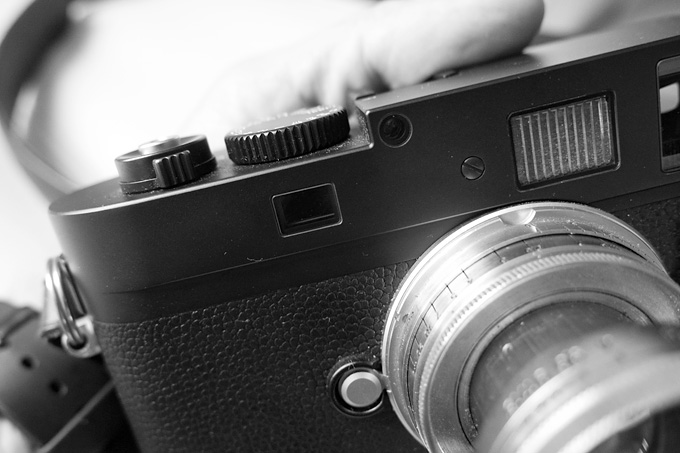
Many have wondered why on earth they should buy a Monochrom when they may have a Leica M9 already. Let’s forget about other cameras for the moment because if you shoot an M you want to shoot an M. You want that experience of shooting with a rangefinder, a hand-built work of art. If you love Leica then you want a Leica.
So let us say you have an M9 and you have been itching for a Monochrom but you are not sure if there is even a difference between the files when at the end of the day you can convert a color M9 file to B&W.
I have been shooting with both the M9 and Mono for a couple of weeks and comparing results. What I have noticed is that the main things that set the Monochrom apart from the M9 is the fact that you will get MUCH less noise at higher ISO’s and you have the capability to go up to ISO 10,000 with the Mono when the M9 goes up to 2500. The Mono also gives you the Sapphire screen of course but in regards to noise and B&W tonality, IMO the Mono takes the prize when it comes to B&W photography.
It appears that ISO 2500 on the M9 is pretty close to the Leica Monochrom at ISO 6400. Even ISO 10,000 is usable on the Monochrom.
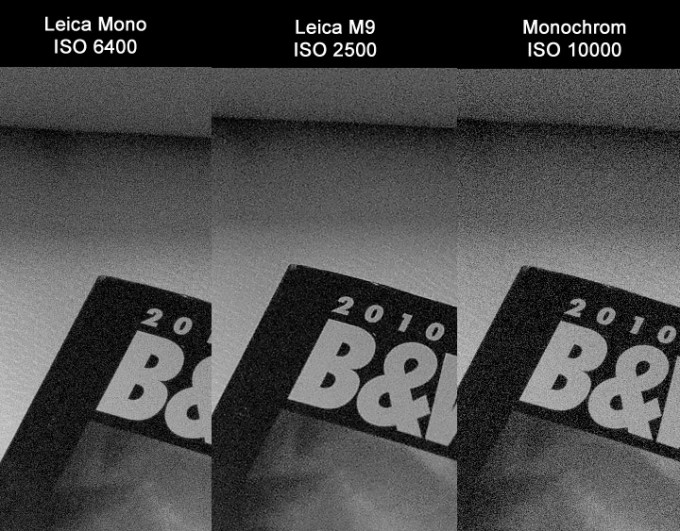
–
and just for fun, and ISO 10,000 crop on the Mono vs the OM-D in Mono mode – NR off.
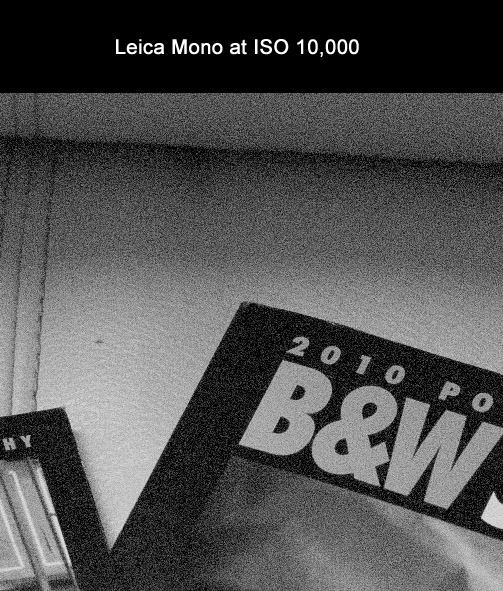
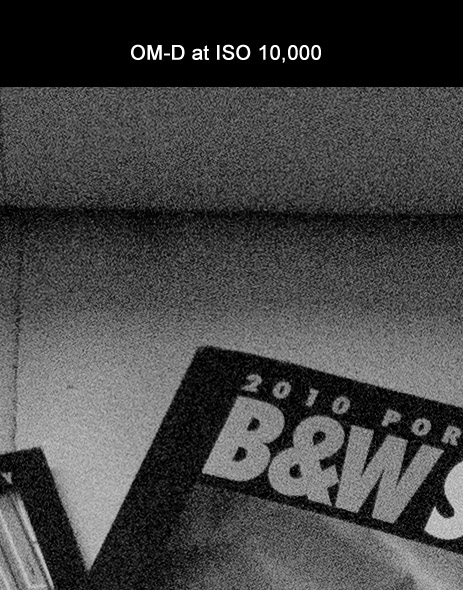
It has never been a doubt that the Monochrom is good enough in low light to take images in just about any situation. Since there is no ugly color noise we get a nice looking noise pattern, even with a high ISO setting such as 6400. 10,000 is grainy but some may like this look. Sort of like shooting Delta 3200.
–
TONES
How about tonality? Can the Mono deliver results that look better than the M9 when an M9 file is converted? Well, maybe not better but the images are certainly different.
1st shot is from the Monochrom – 35 1.4 – ISO 320 and 1/4000s – this is the full size file so you can click it to see it full size.
–
When I focused the M9 shot I realized after I was back home that the focus was off a bit so this is not to compare focus but to compare tones after the B&W conversion. I used Alien Skin exposure. Same camera settings. See a difference?
–
One more to check for tones – 1st the Monochrom…BOTH converted using the same preset…
–
And the M9 converted…
I’ve noticed the whites with the Monochrom are a bit more grey. The grey tones are darker grey than what you will get from the M9 converted color file. So is it better? Possibly, for some yes. For some no. I think what it all boils down to is if you want to get into the “Monochrom Mindset” and only shoot B&W. If so, the Mono will force you to do it. With an M9 you will sometimes keep the color file and therefore you may not start seeing in B&W as much as you would if you were shooting with a Monochrom.
“Kids 1st Zombie” – Monochrom with 35 1.4 – noise added via filter in Alien Skin
–
“Beat the Drum” – 35 1.4 – filter applied in Alien Skin with grain. EXIF is embedded.
So what is my overall bottom line conclusion on the Monochrom? Well, there is nothing like it. Period. To have a Leica M body in all stealth charcoal black without markings that only shoots in B&W is quite the conversation starter. It is a camera that you really can’t get until you use it…hold it..press the shutter. Is it worth $8000? To me, no. To you? Maybe. The files that come out of this camera when a shot is properly focused with a good lens are mind-blowing. Prints..I can only imagine (coming soon..big prints from the Mono).
There is a richness and tonality to the files that come out of the Mono that are very pleasing but do take some getting used to. You can get results that are very grey and flat but you must have that eye in B&W mode to find the right situation for a good B&W photo. Once you get that down as well as the processing and filter use then you can start to feel comfy with the camera.
The Monochrom is not for everyone but for those who dare step into this territory then I feel you will be happy knowing you have one of the most different cameras on the market. A full frame Monochrom only sensor camera with classic beauty, classic handling and even classic usability. Mixed with the ultra simple controls of focus, aperture and shutter speed and you have a winner for those of us who want to shoot in a pure way. The Leica Monochrom gives us that.
Only you can decide if it is for you. B&W only, Superb ISO performance, Gorgeous files in a Leica M body. $8000.
“Hey Brother can you spare some Brains”? – Mono with 50 Summitar
Where to Buy the Leica Monochrom?
If you want to buy one of these and are prepared to take the heat from your significant other about it then you can buy from one of the following dealers, all of whom I recommend:
Ken Hanson – email at khpny19@aol.com
The Pro Shop – 561-253-2606
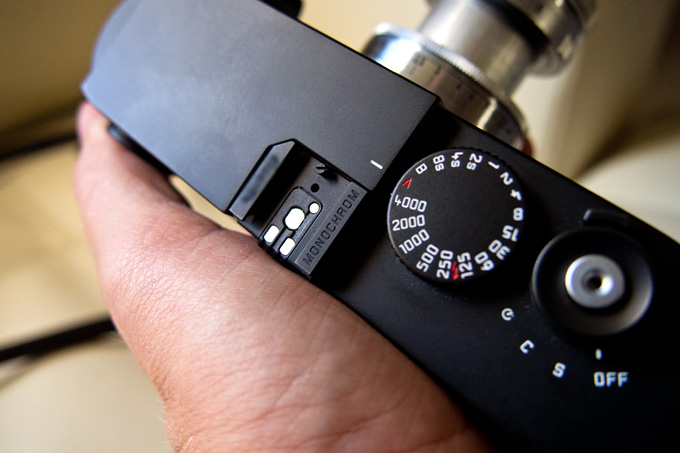
The only problem is that this camera is back ordered and usually dealers have wait lists going on. Be sure to check with all dealers to see where they stand on stock and tell them I sent you!
Zeiss 50 Planar at 2.8
What else can I say?
After 3 previous parts to this review and several other posts prior to these I feel that everything I could say about the Monochrom has been said. It is what it is and you know if it is something for you or if you would benefit by owning one. All I know is I am in love with mine and will continue to use it during those times where I feel B&W would suit. I may even be inspired to go out and start a new series like I used to do when I had more time. Maybe pick up on my Homeless Project where I left off a few years ago. The Mono motivates 🙂
Zeiss Sonnar 1.5
HELP ME TO KEEP THIS SITE GOING AND GROWING!! IT’S EASY TO HELP OUT & I CAN USE ALL THE HELP I CAN GET!
PLEASE Remember, anytime you follow my links here and buy from B&H or AMAZON, this helps to keep my site going. If it was not for these links, there would be no way to fund this site (and the cost these days to keep it going is pretty damn high), so I thank you in advance if you visit these links. I thank you more if you make a purchase! I have nifty search bars at the upper right of each page so you easily search for something at either store! I currently spend 10-14 hours a day working on this site and the only way that I can pay for it is with your help, so thank you! Currently my traffic has been increasing but my funds to pay for the site has been decreasing, so any help would be GREATLY appreciated!
Even if you buy baby food, napkins or toothpicks at Amazon it helps this site, and you do not pay anything extra by using the links here. Again, you pay nothing extra by using my links, it is just a way to help support this site, so again, I thank you in advance ![]() More info is here on how you can help!
More info is here on how you can help!
If you enjoyed this article/review, feel free to leave a comment at the bottom of this page and also be sure to join me on twitter, my facebook fan page and now GOOGLE +!
Also, you can subscribe to my feed at my subscribe page HERE and read these posts in your browser or news reader!


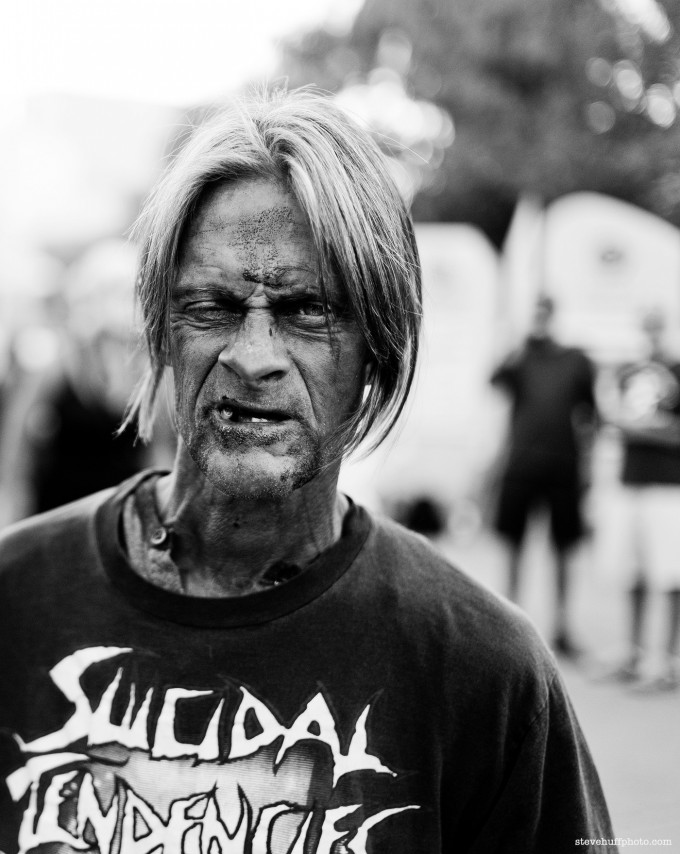
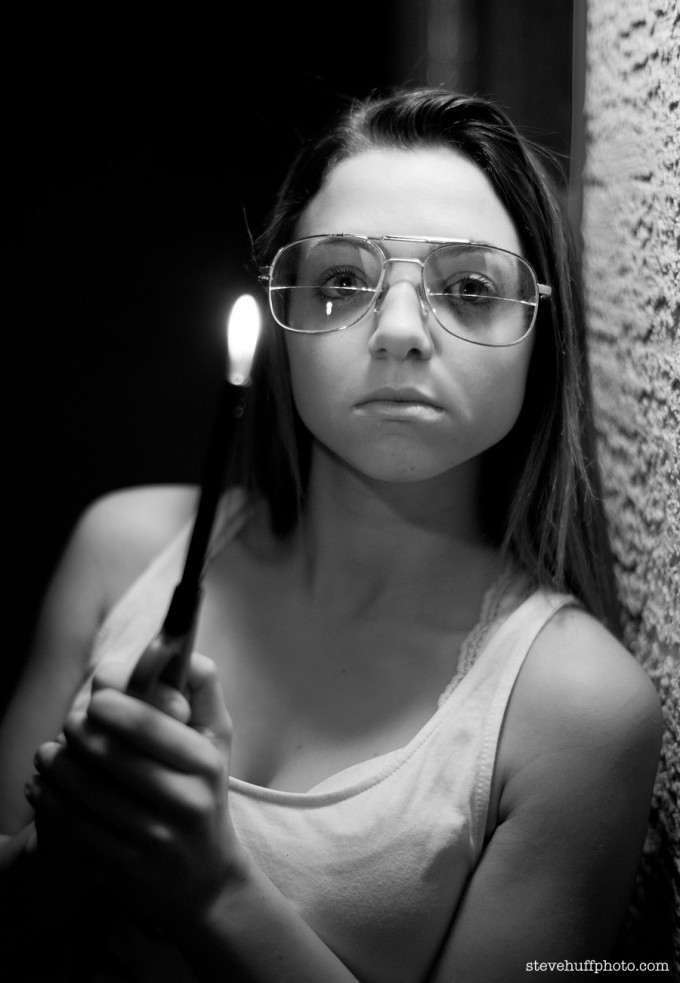
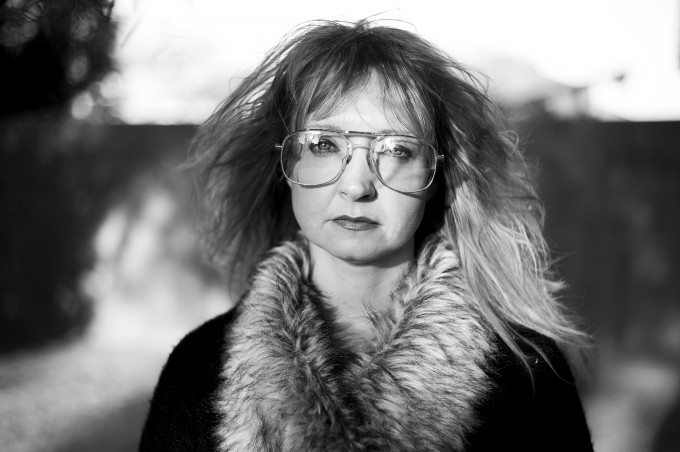
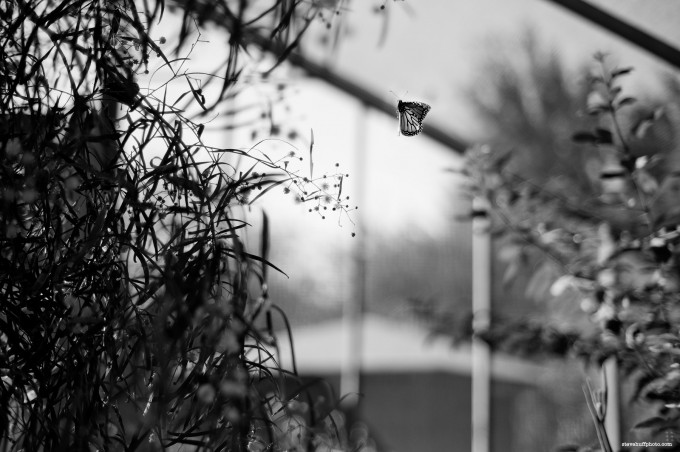

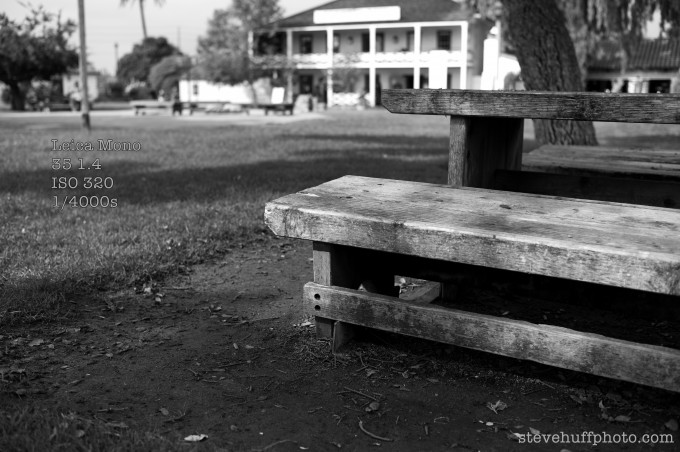
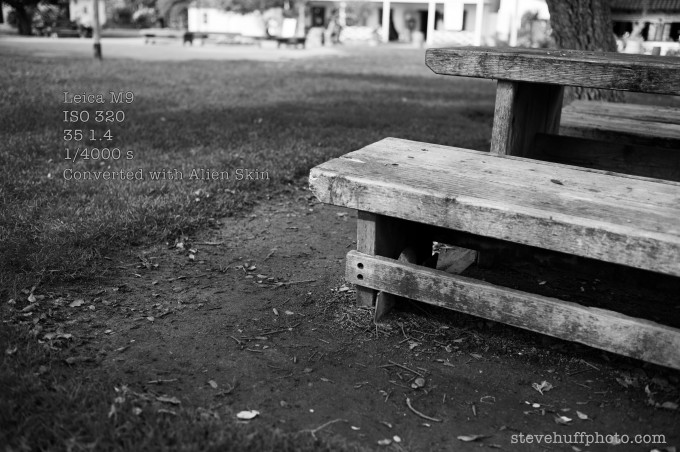



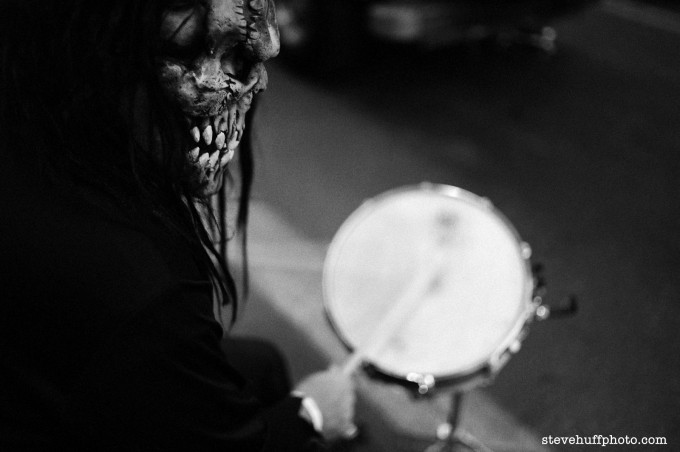
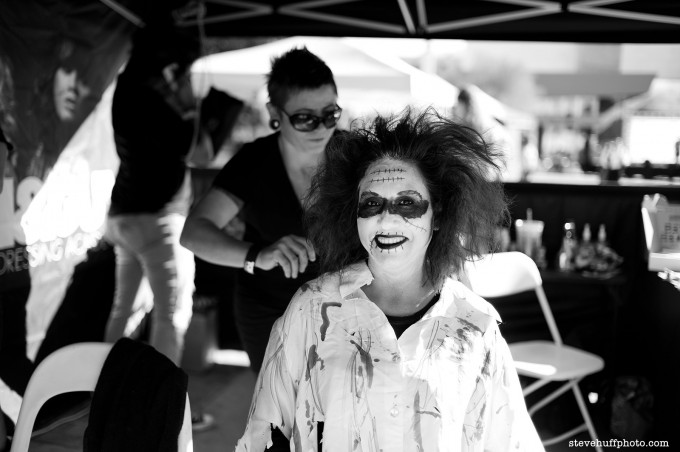
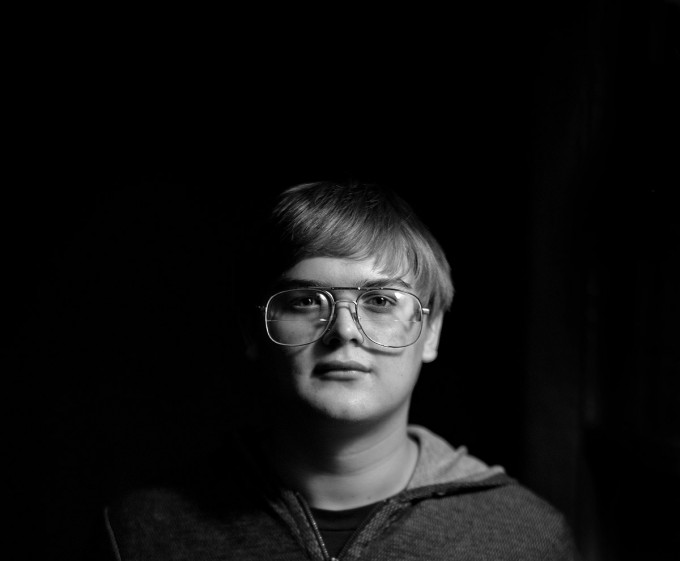

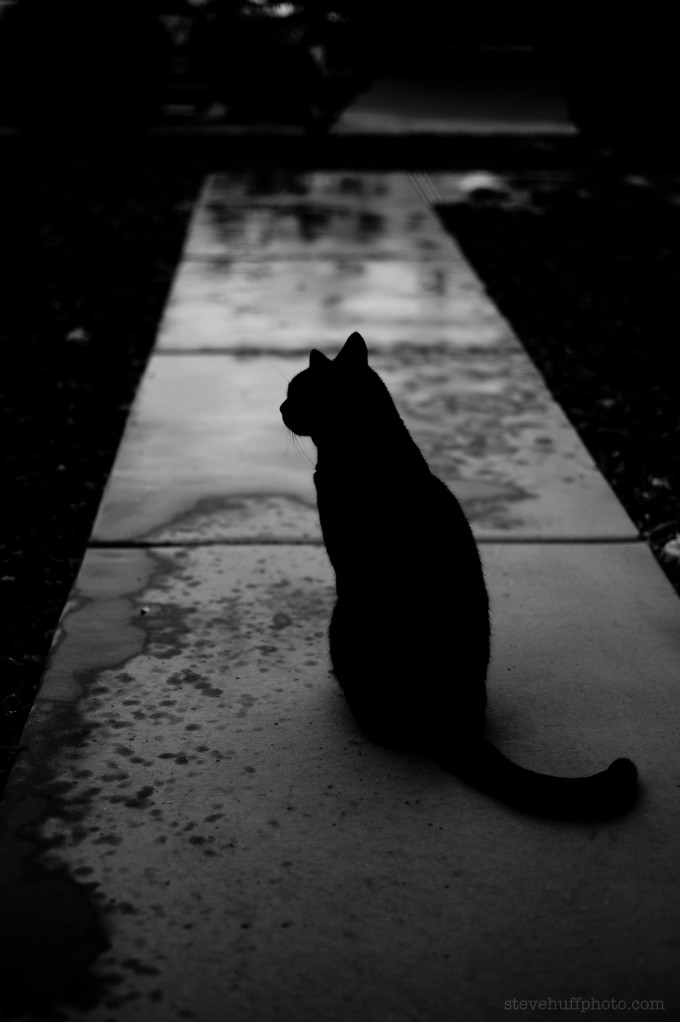
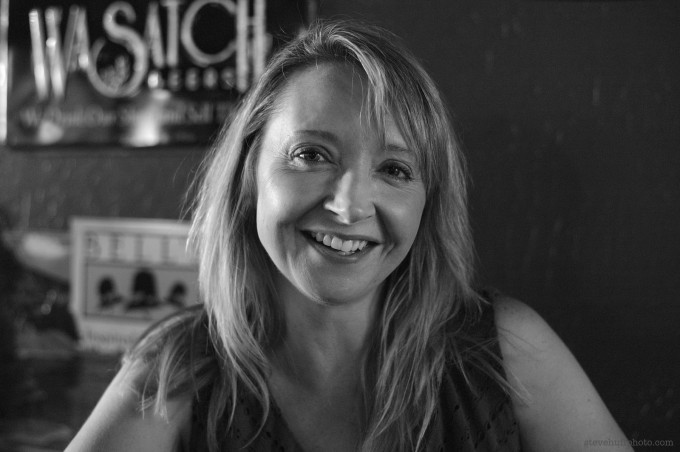
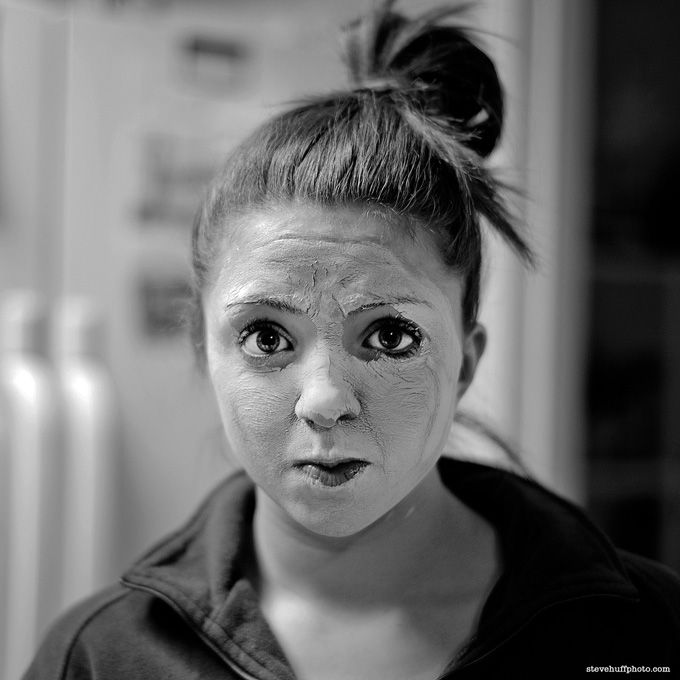
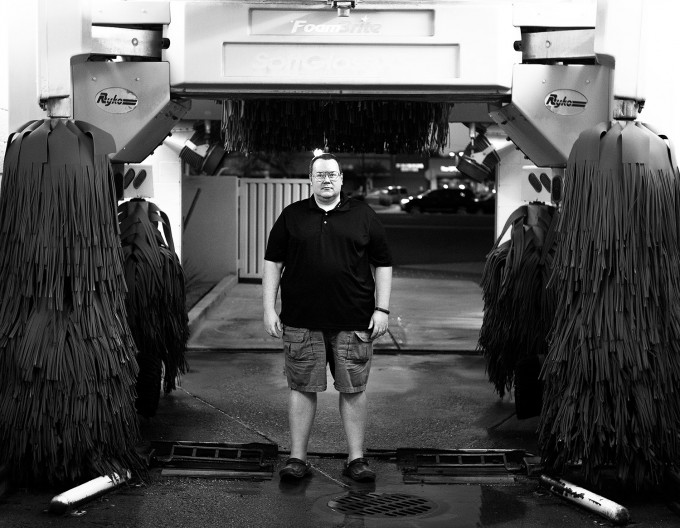

sorry for my ignorance.. i found what i needed in part 2. please disregard my previous comment of filters. thanks
Steve, thank you for the review and the test results. what is your opinion about optical color filter use (high quality b+w for exp) on the mono M and the effects on final medium to big print results?
For black n white film shooters, it is essential to use filters even on a leica, and as you may well know, filters didn’t affect film resolution but greatly sucks out pixel resolution from the color array digital sensors, leaving flat tonal areas in some cases with strong filters, killing the picture in print.
– is this monochrome sensor better suited for filter use and to which extent?
– is it more appropriate to simulate those filters in post production rather than optically? and if so, does those computer simulations in raw i presume, give the same satisfying and edgy effect like using optical filters?
i hope im not asking too much, but i think that such a review on filters use, would be very popular since it will be rare to see another monochrome camera soon.
thanks
is the butterfly “in flight” dodged in photoshop? not to be cynical, masters of photography also dodged in darkroom printing.. just asking. thank you
i know that this camera was worth the money because when people see the photos i get asked whether or not i use a pro film scanner for my negatives 😛
This is a very nice article. I am an BW photography and Leica enthusiast. So, I have been trying to justify the budget for Leica monochrome. But, I couldn’t succeed yet, because, there are three major issues.
Main advantage of Leica Monochrome is its sensor. There is no bayer filter, so, each sensor can only see true luminance values which makes it “true monochrome”. It makes no sense for me unless the following equipments are “true monochrome”
1. The picture’s file format. Leica Monochrome saves in DNG format which stores each pixel as a combination of RGB. DNG is a color format as far as I know
2. If your plan is to view the Picture on a monitor, then, it is very hard to find a “true monochrome” monitor. 99.99% of the LCD monitors in this world are RGB (color monitor).
3. Alternatively, if your plan is to print the Picture; there is no “true monochrome” printer/enlarger. You must go to a print shop which most likely uses a color printing machine which is also RGB. There is no “true monochrome” printer/enlarger.
As a result, I don’t see any good reason to buy Leica monochrome since it will give the same results as those which are taken by a BW film, scanned to PC and processed by a software like silver efex pro 2.
I am pretty sure that it takes sharper pictures than film, but, this makes no sense since they are monitored by color monitors, or printed in RGB format.
It would be superior if there would be; a “true monochrome” printer/monitor which supports “true monochrome” file format.
Regards!
at the end it is the result that u are seeking, not how it is achieved. The removal of the bayer filter means the machine will give you a tonal result much identical to what film did, which is a stronger and edgier monochromatic interpretation of the scenes than bayer filter cameras. technology in black and wht printing today provides results on par in tonality and feel, with darkroom analogue negative printing. But it all depends on not abusing the file in post production. This camera is for those who want to skip post production, shooting and going straight to printing, and by doing that you’ll end up with realistic and beautiful files and prints of b&w.
Steve,
I very much appreciate your plain language Monochrom reviews, comparison shots, and opinions. In fact, your reviews are better and much more helpful than the stilted language and obscure technical jargon of the M MONOCHROM marketing article in the January 2013 LFI (Leica Fotografie International). Your reviews are also better and more informative than the Leica marketing info that most retailers attach with their Leica M Type 240 and Monochrom listings and pricing. Leica should hire you to write their marketing info.
I hear what you say about converting M9 shots to B&W vs the Monochrom designed B&W only. My remaining question is: Leica M Type 240 vs Monochrom? I look forward to reading your thoughts.
Thanks so much for your time and effort,
Stuart Feen
Thank you Stuart. I am happy you have enjoyed the reviews.
Steve
Hey Steve
Thanks for the review. In fact one of the reasons I got back into Leica photography after 20 years away was your great informative reviews. I have a M9 and use a MP for B&W, I was considering getting a monochrome, then I talked to some people about the sensors. It seems that digital sensors have a lifespan of 5-10 years before the pixels start to die off, is that true?? If it is, I am a bit hesitant in spending another 8k for a digital camera when the film cameras will last as long as there is film available. Any help in clarifying this issue will be appreciated.
Tsai
Hi Steve, I can not find fault with the MM, and top ISO, there should be a book entitled; ‘The Joy of Using Rangefinders, more specifically The Joy of Using the MM!
I find myself playing with the curve in Lightroom 4!
Know what I mean, nudge nudge, wink wink.
Thanks for the review! I think you made a fantastic point – the Monochrom’s ability to offer PURITY in a digital image. Nowadays, I either shoot film or heap edits onto my digital files to replicate the character of film. This camera seems like a lovely way to, if you can afford it, replicate the joy of shooting a roll of black and white film through a camera. And the film never runs out!
Hmm…I have to say I am not a fan of the Leica Monochrom with the 50mm and 35mm posted above. I don’t like the clinical sharp look in B/W photos. I don’t think it has anything to do with getting used to it, there is something about it I can’t articulate that I don’t like. Steve you’re shooting is great but the B/W looks really weird. Honestly everything looks as it someone took a color photo and threw it into Photoshop to make it B/W.
I think there is promise though with the Monochrom. The classic lenses that Ashwin Rao uses looks much better. Even those come off weird because they seem too grainy…
I agree with you. The modern lenses do not jive well with the MM it seems. I prefer classic glass and Zeiss ZM glass. I feel the Zeiss ZM glass is just about perfect with the camera and is now what I am using with it.
Would have loved to afford a Leica MM or M.
My only concern is that while the analog Leicas were made to last a lifetime, there seems to already be problems with repairing the M8 or M8.2 as electronic spare parts are no longer available (from what I read). Investing in a Leica would be something I could do at some point, but then to have that camera last for a couple of decades. I’m not sure this is feasible though. Digital products seems to decay and if lack of batteries are not a problem, then parts made from other vendors may go out of production as they are replaced by something better but not compatible.
Hopefully at some time in the future, if I can afford a Leica, these issues are not longer a problem.
Steve, I am a regular reader of your site and have to say, apples to apples, this is the best series of photos I have ever seen you post. Not that the others aren’t good, either. Just makes me think something about the camera / photographer combo is really working well here. Which in itself is a great endorsement for the Monochrom.
One small comment, can we all say less about the price and value for money when reviewing Leica? It is what it is, and not because Leica is arrogant or greedy — only a few years back they nearly went bust — but because they are hand built products with small production runs. Without their boutique size, Leica could never have produced a niche product like this camera, or some of their most wonderful lenses. We are used to other products priced according to the same economics of production and I don’t see anyone attacking or defending them on grounds of price or value. I never read, say, a Ferrari review with a third of the text arguing about the price. If you love driving, the Ferrari is what it is. We can either afford it or dream about it. It offers one kind of driving experience. Not the only one, not always the best one.
Just sayin’
in October 2009 I posted on the Leica forum, that I would buy a Monochrome instead of the M9 – I had to buy the M9 at that time.
3 years later I got one of the very first MMs and started loving it from the beginning.
(You did not have time for my first impressions at that time, Steve)
I am an 70 years old photo aficionado since 1955 and for me the MM is the long way back to the roots and photography pure. I assume, that most posters never have seen a print from the MM jet. I showed prints on A2 (40x60cm) on Hanemühle in B&W from the M9 and from the MM and from the MM even on A1 (60x80cm) on my last exhibition and the MM images are just impressive!!!
If you have the chance, go and see real prints from the MM.
I do less street but more landscape, portraits and some stills. I never had clouds like the ones out of the MM with an orange or even red filter before. In clouds you see the difference imo.
You may find many MM images on my
I love my MM 🙂
Nice photos dierk!
Lots of lovely pictures Dierk. You use the MM in a beautiful way.
Your getting a terrific dynamic range Dierk on some beautiful landscapes.Can I ask how much you need to work the files to get such an impressive result,is it a case of exposing for the highlights and then working on the shadow areas of the image,…are the filters a big help?You seem to be able to hold the highlights even with the red filter,impressive work.
thanks, Andy, IIIf and Neil 🙂
yes, the MM is capturing a fantastic dynamic range. I mainly used LR4 for B&W conversion, only seldom the Nik Silver Efex (I have it since the first beta version for my B&W). With the MM I use Nik most of the time and I am always surprised, what Nik can get out of the image, especially the shadows. The trees are no longer just dark grey (depending on the filter of course) but the tones and structure just pops up. The new version of Nik Silver Efex Pro2 has so many different sliders, that you can get any look you want! And the U-Point technique does the rest.
I forgot to mention, that I made a print on Hanemühle A2 from an ISO 2500 shot and I am sure, no professional will notice it.
I made a mistake with the link to my flikr. I try it again (if it does not work, click on my name):
For me only the result is important, not the making of (analog, digital,… painting 🙂
After a long way of almost 60 years from my first Agfa Box, SLR Edixa Reflex, Minox, Horizon,….6×6 and Gandolfi 4×5 I am back to the roots (as mentioned before). With such a fantastic tool in my hands and knowing, what I can do with the images and that I can achieve the result, that I have in my head is like a dream. (I would rather save 5K on my next car for useless extra stuff!!)
If I had to choose the minimum gear, I would use the MM and the Nex7 and that is actually, what I put in my bag or even my pocket most of the time
Thanks for reading and looking
dierk
Steve: just thinking about your Homeless project. Clearly the M absolutely fits it. Wanted to ask you: Do you know the work of Danish photographer Marie Grøndahl (Groendahl, if the danish character doesn’t come through)? Her book “Udstødt” (Udstoedt) = “Rejected” would be worth a look for you for the images alone even without the (Danish) text. All the best! jn.
Thanks, will take a look.
Okay Steve, you like the Leica Monochrom, and you are happy. But I still love my Leica M9P, it just pumps out beautiful pictures with my Leica lenses, so I am happy too. I still have all the yellow and green filters for my old scchool Leica M4, but I rarely shoot in B&W anymore, because film is a hassle, but like you said, $8K is a sticker shock, so I will stay with color.
Good choice. The M9P rocks.
I rented the Mono for a few days last week. (I also shoot with the M9 and M8). I think you have to see these files at full rez, on your own screen, to really get what all the fuss is about. On paper in seems so illogical, but I just loved shooting it, and was blown away at its sharpness, tonal range, and especially its low light ability.
I’m a low light shooter, the M9 is not. I just hate hitting that 2500 ISO wall. Will I buy a Mono? I feel I’v got to wait and see what the “New M” is going to do first. The Mono really made me stop and think about what kind of image making I really want to do. That weekend I used a Sony RX100 and the Leica Mono. I suddenly felt like I had all the bases that mattered to me covered, in a very compact ( albeit expensive) package. I hated returning it thats for sure.
Been following you for years now and got into the rangefinder system primarily on the strength of your reviews. Just rented the M Mono myself, and, sadly, have to return it tomorrow.I had zero interest in even considering this camera. Everything in your is spot on. The MM is a keeper. And just put my name on a very long waiting list. IMHO, this was one of your very best reviews, ever. People should understand that, like film, darkroom/post-processing is essential. But the M gives you an unbelievably solid grayscale foundation from which to tweak to your liking. It’s a camera that has a learning curve and also requires subject/compositional thoughtfulness. You must take your time, but the rewards are breathtaking.
Wow, thanks Ron. That is what I have been saying. To understand it, one has to use it..feel it..experience it. Sounds like you did just that but I feel for you! Now you had a taste and have to send it back!
For me the black & white images you took with the RX-1 just trounce the MM images for both tonal range and pop. They made me run out and put my money down on the camera. The images from the MM just don’t do it. The shot of your girl friend has the best look of any to me but it still doesn’t match the RX-1 shots you took. And, if I recall you had to put those images together quickly with minimum time or fuss in PP. Maybe others see it differently.
The RX-1 B&W’s def have more pop and wow…and yea those were very rushed 🙂 Thx for reading!
+1…..the CMOS sensor no doubt brings with colours and contrast and this would translate well to B&W’s. The main difference will be the rendering in colours of the RX1 vs CDD. Good but different.
But yes good enough to buy the RX1…imo!
Cool Leica Monochrome review!
Perhaps Leica needs to adjust the default tone curve and brightness to get rid of the overall middle-grey look.
i like the MM consept but i have to say most of the photos here would work better in color.
oh by the way there is one thing im really curious about the MM results. have you tried any nighttime flash photography? i feel like this would fit really well as a night camera for street but considering the highlight cutoff issue im not sure how it would handle a face lit with flash in close proximity.
Thanks Steve and other contributers for these excellent reviews of the Leica Mono. I am a street photographer from Dublin Ireland and I always enjoy dipping into your site. I use a Leica M8 with 50 and 35 summicrons and an ol Pentax K1000 for film. I have always considered the M8 to be an excellent camera for black and white and use the Pentax for that true Tri-X look on occasions. From what I have seen here and elsewhere on the net- the Leica Mono seems to be a true classic camera that delivers stunning black and white files the like of which I have not seen before in digital ! Some day I will be getting one. As somebody else said previously- It is not excessive to spent such sums on something you like and use in a creative way expecially if you are not spending like mad in other areas.
Best wishes to all B+W Photographers out there.
Incredible to me that so many people can be so vehemently against ANY camera having never, not once, even shot one single frame with it!
I don’t need to use a camera to know what it’s about. I know this camera doesn’t shoot color. I also know there’s no difference in tones to my eyes. There may be a slight difference but it still makes no sense to me. If you want the high ISO and only shoot BW then that’s the one Pro I can see. Not many people are so dedicated to BW to shoot 100% BW so you will have to have another camera. One of the best things about Leica is the colors.
“I don’t need to use a camera to know what it’s about.”
Ok. I do.
Steve, wonderful photo’s man.
And people (myself) may criticise Leica for their pricing strategy – but there’s no denying the results are wonderful (in the right hands)
🙂
Aren’t you glad ibraar, that Steve lets you criticise Leica without him acting childish and telling you with your own favorite phrase to ” go forth and multiply”?
After reading the comments here, with some for and some against the Leica mm, I have to tip my hat off to Steve for letting his viewers make their oppinions. Freedom to speak and comment without getting a childish response from the poster, isn’t that a novel idea, ibraar?
There are limits to the amount of post -processing that is allowed in an image in serious photojournalism.The heavy processing needed to make the monochrom’s images aproach normality could possibly make them unacceptable as accurate documents.
The problem here is that digital is inherrently UNatractive and without postprocessing is not even representative.It seems that not even leica is able to make digital black and white beat a simple roll of tri-x.
Adjusting a tone curve should be just fine. We aren’t talking about retouching images.
This is not a plug but I wonder what difference in IQ will Leica mono have against these cameras.
http://www.maxmax.com/b&w_conversion.htm
http://www.maxmax.com/monochrome_camera_order.asp
They have been converting cameras to bw only since 2005.
I wish Sony, Fuji or Olympus would make a monochrome sensor mirrorless. I’d buy it in a second!
About the flatness of the output–people just don’t seem to get it. You need postprocessing to get any kind of contrast you want out of this camera. The flat files have a wealth of tonal information that punchier out of camera results would not have. They make perfect negatives.
With film the tools available for contrast manipulation were very crude compared to digital, so the contrast inherent in the negative was much more important.
There is also a significant upgrade in detail compared with an M9, since there are only true recorded values in the Monochrom, whereas every single pixel in the M9 is interpolated in part from its neighbors. The only ways in which an M9 (or other comparable color sensor) would be preferable for B&W would be for saving overexposed shots, compensating for CA, or selective color filtering after the fact.
I appreciate the reviews and comparisons so thank you for that.
For the MM I’m just not a believer. If you really really need high ISO and B&W is your thing I guess I can see that but for me the M9 is King. I doubt many if anyone would be unhappy with M9 files converted to B&W.
Steve misses one very important element when shoot filming, the actual process of shooting is completely different with film compared to digital.
A slower paced more thoughtful experience is film. You tend to not shoot around a subject to get the image with film, you WAIT for the strongest moment. It is this very thing that sets film apart.
Go have a chat with Alex Webb, yep, he has shot with the M9 and as he plainly states, ‘I just do not get the same frames, the same moments with digital – irrespective of WHAT digital camera it is – it just does not feel like an extension of my body as a film M does’
Ask any pro, me included, and they will all tell you that their actual quality level, the images that have impact have lessened massively since digital – as the entire way you shoot is different to film.
Give me a Mamiya 6 with one roll of B&W and a Leica MM and i guarantee there will be stronger images in those 12 thoughtful frames that the 200 I shoot with the Leica digital.
This seems to be something Steve does not consider – its all megapixels, sharpness, tones blah blah blah than the actual method of shooting film vs digital.
Try a Contax S2 (I have a New Old Stock one). Only ten years old, built like a jewel, spot metering only, and targeted at the “Deliberate Photographer”.
It’s a camera that for several reasons slows you down considerably. You’ve got to make every shot count (I manage about 20 out of 36). It certainly teaches you to think before you shoot.
Nice camera though!
There is no doubt. Most don’t get it. As a film user, I get good mileage out of the Monochrom because I use the same approach as with film. I’ve learned how to expose with it, don’t look at the screen and I take it slow. Having said that, there simply is no substitute for a roll of Tri-X through my Rolleiflex or Holga. Totally different animals. Then again, I only judge photography through prints, not digital renditions on a computer screen. I’ve made photogravure prints from the Monochrom that are as beautiful as anything I’ve ever done with film. Nobody could tell the difference.
Michiel > ‘It certainly teaches you to think before you shoot.’
Sorry…but that is such as cliche. I owned a Contax G1 as well as an M8….both cameras that people love to say, ‘teach you to think before you shoot’. Actually, what they are is slow (in comparison to any DSLR).
I loved both cameras but let’s not dress up their warts as some sort of esoteric feature. It’s kind of like justifying the size of DSLR’s by saying they ‘force you to work out’.
I acknowledge that Clint, and I meant “teaches you etc…” in a slightly ironic way. The S2 is for some ergonomic reason slower than my FM2n.And of course, don’t I wish I had good autofocus, reliable 3D colour matrix metering, higher ISO at the flick of a dial…
I love switching to and fro between manual, mechanical and my D700.
helbron,
why not shooting thoughtful 12 frames with the MM?
Great write up Steve
The Mono is the ONE.
A turbo charged fine art machine. A Panzer Tank of a Camera.
I must obtain this camera a.s.a.p.
Shame i keep waking up a very poor soul clutching a battered X100.
Enjoy the learning curve and keep posting the results.
Oh, and thanks for a honest and interesting collection of your thoughts.
Hey Steve would you be reviewing the Leica APO-Summicron-M 50mm f/2.0 ASPH Lens once it’s available while using the MM and M9 for comparison?
I bought the MM after reading your review and am very happy with the experience and results. Keep up the good work!
I’ve always enjoyed the arguments pro- and con- for the investment in a device like a Leica camera. Whether years ago for a film variety or the current digital. Many are simply aghast at the prospect of paying so much for something so small. Yet no one seems to bat an eye about ponying up $50 grand (or vastly more) for a boat you might get limited use out of. Typically you might take it out on some weekends for about two months. Gas and upkeep (mooring, winter hauling and spring prep) are extra. I dare say the ‘fool’ who buys a camera like the MM will probably get a lot more use a lot more days than the more acceptable guy who bought the boat (which by the way has always been referred to a hole in the water into which you pour money). Think the boat example is a bit extreme? How about motorcycles. Lots of folks (particularly ones in their mid 40’s to 50’s decide to get a fine motorcycle like a Harley Davidson with all the trimmings. Those beasts cost anywhere from $8K to $23K (or more if you decide to customize it). Then there are all the trappings, the googaws you buy for it like a fancy GPS and, of course, the pricey leatherwear. Again depending on the region and your lifestyle I’d dare say MOST of these purchases are taken out for a few hours on a Sunday (when the weather is good) for maybe a half a year (April til October in many parts–your mileage may vary). A photographer could easily get 24/7 use out their investment, keeping the camera at the ready by their side for whatever they may encounter that’s worth preserving for all posterity. Maintenance is nil. Film is even nil-er. And processing these days has been reduced to inks and paper.
It’s all relative.
Very good comparison with Harley Davidson.
Photography for me is not only limited to the final result, but in the highest degree the process to the finished result, and here I love Leica M9, and will surely love MM even more with the restrictions it contains, and the whole philosophy of monochrome starts before picture is taken.
Belief in the whole process rubs off on the final result, and not least my own fun with photography.
If it only depended on the outcome, it would certainly be faster and perhaps better to use Canon X1 – but it would certainly be very boring.
$ 8000 is a lot of money for a Leica MM – but better that than afford to be buried in a coffin of gold
The H-D analogy doesn’t really apply imho. I’ve ridden MV Agusta F4’s (the pre-2010 ones) for a few years (when H-D owned MV Agusta) so I tend to be a bit elitist in this respect. H-D’s are cheaply made out of cheap materials, compared to the MV’s. So let’s use them (ok, and Ducati’s) for analogy purposes.
Why would anyone want to own and ride a Desmosedici (nicely featured though not expertly ridden by Jason Statham in The Expendables) @ some 60k USD, if you’re only a mediocre rider? Or Christian Bale as Batman on his F4?
Nice try but really, even I could do better than that, and I managed to crash 3 MV’s on the track… 🙁
Some people do though… 🙂
I personally think it’s silly to try and compare the Monochrome to B&W film. Why use a Tri-X filter in post-processing rather than just using actual Tri-X film? Someone could spend the same amount of money and build a fantastic darkroom, buy loads of film and a Leica M3, a lens or two, and still have money leftover to take classes on how to develop film yourself. Quite honestly, you shouldn’t even be allowed to call yourself a photographer until you shoot and develop your own roll of film. But that’s just my opinion…
You might say I’m just one of those people that doesn’t “get it”. Well, I do get it. It’s a great camera I’m sure and will only appeal to that small market, which is what Leica is known for. I’ve used Leica enough now to form a competent opinion on their cameras. I think the M9 is a great camera and very special, where most digital cameras are missing that special “magic”, the M9 isn’t missing anything. But honestly, I’d rather carry my $150 setup of my K1000 and Super-Takumar 50mm 1.4 and Tri-X because I know I can achieve the same results.
Photography should be about the actual photographs, not the $8,000 camera you have strapped around your shoulder. Don’t turn photography into a status symbol, you’re not a good photographer because you bought a Leica, you’re a good photographer because of your eye, and you can see the extraordinary out of the ordinary.
I couldn’t have put it better myself Khunya (whilst staring at my recently acquired mint Nikon F3 with 2.8/28 Ai-S, loaded with Tri-X).
Yes, you can apply a Tri-X look to the Monochrom files. But the Monochrom also delivers an image quality that exceeds analog medium format. It has a high ISO performance that is unimaginable in analog photography. And it’s digital with all its benefits. This camera is expensive, but it’s one hell of a camera!
So why would you want to make the Monochrom files look like Tri-X? Because you CAN. The other way around, you just CANNOT get the image quality of the Monochrom from 35mm photography.
So what? Digital, colour or b&w, should look good in its own right. Copying film look is pathetic.
I agree, traying to copy the film look in a digital image is sad. It’s like synthetic wood or synthetic chocolat.
Why do you tie the look of an image to the underlying technology? If you like the look Tri-X gives you (tonality, contrast), who cares about the technology behind it? Who cares *why* it looks that way? This is *not* copying, it’s *adapting*, because you are just modifying the image to the way you like. Those filters are nothing else than presets in post. You’re even free to further “improve” on that look as well. I think it’s ridiculous to think only film is allowed to have that look.
Well, you have an interesting view about that. But I’m not convinced at all. I’ve shot lots of film and lots of digital and in some period of my work I’ve tried to “adapt” (in your words) digital to the look of some films by many ways. Never I could. I was never satisfied. At that moment I understood. Digital is digital. Film is film. I understood digital is a medium with other expressive possibilities. Why to adapt it? Well, you can, but don’t pretend after that you have something like film…. that’s only synthetic film. If you really appreciate the look of film in all its aspects and the user experience in analog, including developping, so use film. That’s what I continue to do. I’m very happy with results. So, who cares? Me. I don’t need more reasons.
I agree with you that you should not try to imitate the film look as closely as possible (and even be dissatisfied when it doesn’t work). Digital is not analog and that’s a good thing. Why pretend to shoot film when you really aren’t? Just making a photo look like film for the sake of making it look like film doesn’t make sense to me, either.
But nevertheless I think there is a difference between imitation and adaptation. Different films have different looks to them. So if you chose Tri-X because you liked its tonality/contrast/whatever then you might want to keep those attributes with your digital camera. Personally, I use SilverEfex for B&W images, adjust the look to how I like it, and save it as a preset. Film filters are nothing else than presets for specific adjustments, too – you can use them directly or modify them further (refining what you originally liked about Tri-X). The result of course is not Tri-X, but a digital photograph with similar visual qualities.
I really doubt if any of the digital posters here defending the use of “Tri-X” and such, have any knowledge of the sometimes subtle or not so subtle differences in processing Tri-X. Pushimg or pulling, or exposing at box value, using different developers, different developing/agitating/standing techniques? Using HP5+ instead, or Delta400, or TMAX400?
Give it up. Digital is digital, worthy in its own right. Stay away from the chickening out filters, layers, alien skins or whatever.
Getting to back to Steve’s MM images, they mostly seem underexposed, which would explain the dull whites and muddy greys.
Give it up. Digital is digital, worthy in its own right. Stay away from the chickening out filters, layers, alien skins or whatever.
Maybe I’m missinterpreting you, but tools like SilverEfex (and I believe AlienSkin has manual controls as well – haven’t used it) or Photoshop (that’s were you usually work with layers) are the digital equivalent to a dark room and are essential parts of digital post-processing. Advising to stay away from these things is like advising to bring your undeveloped film to your local grocery store for development and prints instead of doing it yourself.
What’s funny is that Willi thinks this MM will outperform MEDIUM FORMAT film in terms of IQ! What a F**** joke!
It can’t even outperform 35mm film! The fine grained type, not Tri-X. 35mm film can still have much more resolution than this camera. Medium format, even more.
“Quite honestly, you shouldn’t even be allowed to call yourself a photographer until you shoot and develop your own roll of film. But that’s just my opinion…”
thats a load of rubbish……imo!!
there will be people out there who are better or at least as good as current and past photographers (and can call themselves that!) who will in the future never use film.
To vary on the statement you so vehemently contest: “You’re only a real photographer if you know how to handle a fully manual camera, analogue or digital”.
Agreed?
You’re only a real photographer if you know how to handle your camera (manual or not – it’s the results that matter) and know how to compose an image. If you lack the latter, you’re just a trained monkey.
True of course, but all that is preceded by a basic understanding of how a photographic image is created, digitally or by film. Aperture, shutterspeed, depth of field, light, shadow, colour of light. Then comes shape, contrast, how an image might be built up, previsualising that, the amazement at what comes out.
Most images here are no more than cute snapshots or gear demonstration shots. Useful in their own right, but downright boring from a photographic point of view.
As for the filters? Pseudo-film overlays are a no go area for me, and the less post processing an image needs, the better it usually is.
Yet Michiel there are people who pick a guitar and within days can play by ear. They will never know how to read music.
There are similar people at all levels of knowledge in photography.
As a very general rule I agree with you. But above that if someone has an ‘eye’ and it comes naturally and they do it consistently without too much PP, they are a photographer. Over time they will learn more.
Very general! 🙂
Closer to the mark…….yet people with a gift to see light and compose an image which resonates with people and only use an iPhone. Are they not worthy?
The images or the iPhone people? Maybe, but I wouldn’t call them photographers.
Agree. You probably wouldn’t call them one unless that is their tool of trade and they do it is as a profession. But alas a very small % would just use an iPhone in this example as per Holga and other tools of trade.
My main point from the beginning though was about having processed film……to me it alludes to saying someone is “worthy” of that title just based on this. Almost a bit elitist. It is all about the image…..and in IMO ONLY the image!
Because that is the great thing about photography. It is what all emotions, criticism, critiques, endorphins and what ever you want to call it, are based on.
Not whether it is film, digital, iPhone, Leica, SLR, OMD, etc, etc
Take our conversation above about Don McCullin for example. Great composition, emotive and yes fantastic photographer. However to me there is something not right with the man walking vs the other tones and rendering in that photo. I still love what he’s created but that aspect (to me) lets that photo down. It was the first thing that caught my eye.
Maybe “worthy” wasn’t the correct word, but I used it deliberately, and certainly didn’t mean to apply the term only to film, certainly not.
I’ve been shooting mainly film (Tri-X, HP5+ and expired Agfacolor 200; it came free with a cheap slr) lately and have been neglecting my D700. I’ve discovered in myself a strong leaning towards ’80’s Nikon and Contax slr’s and b&w lately; maybe I should fight it 🙂
and I’d really, really, really, really like it if you did another photo project, like your homeless one – of course shot entirely with the Monochrome. preferably something you haven’t shot before…
Agreed, I really enjoyed those photos too Bt.
Show with an MP IIRC Steve?
In Lightroom, do you use the “Edit Point Curve” in the Tone Curve box? If it works at all…
alas, deleting my comments after all… no doubt you won’t miss one less follower to your site. it is your right, of course, to not acknowledge people who don’t toe the line
Yes, one was deleted. Read the rules. Personal attacks are not tolerated AT ALL.
Dull whites, drab look to it. Perfectly fitting.
http://disphotic.files.wordpress.com/2011/10/don-mccullin-man-walks-to-003.jpg
There ya go 🙂
LoL. Try to emulate that!
I find Don Mccullin’s “social realism” images pretty depressing. Phoenix should be more uplifting in this day and age, unless you have a pretty dim view of life.
Get some sparkling whites!
funny. When i opened this image it looked like the man walking didn’t belong in that photo. Was like he’d been cut and pasted and almost looked too dark and sharp edges…..
The Don would not be pleased with that comment…
Perhaps……but it’s a photo…..you call it as you see it!
Well. It certainly didn’t look unnatural to me. Maybe I’ve seen and made more film b&w images than you.
I have no doubt about that. I am sure you have.
Seriously. Look at what Mccullin did with the contre-jour, and the slight underexposure and/or heavy printing. It’s a very forceful image.
Nowhere near as sharp and technically perfect as the MM’s images of course, but a lot more interesting than what I’ve seen up to now (apart from the boy shot, which is fantastic, riveting).
There was some talk earlier about a possible X series monochrome ,has this hope disappeared ?
You know what, thinking about it I seriously think an “X” series monochrome might actually make a lot more sense as opposed to the MM.
Won’t bash it but won’t spend my money on it either. I like BW but simply can’t afford it. Well at least it won’t be able to buy any lenses for it in a while…
Enjoy reding about it though.
Thank you Steve for your words and samples. I live in Norway and follow your web every day. I bougt the Olympus OM-D a few months ago after your review and i’m so happy with this camera.
Could you post some photos from the Monochrom and OM-D at a lower ISO to compare them in a more normal use and ligtning.
Thank you again and looking forward to later review on the new Leica M.
Best regards
Thanks! Yes, I will do that. I had a crazy busy week last week where I barely had time to breath! Next week is much more mellow so will try to do that. Thanks so much!
I’d be very interested in that, too! 🙂
The high ISO performance of the Monochrom doesn’t look that impressive to me, just maybe one and a half stops better than the M9 – other full frame sensors easily do as well in color! The difference to the OMD at ISO10.000 is visible, but if I had to guess I’d say that’s maybe one stop? And the OMD’s sensor is one quarter the size! I still think it’s unfortunate the Monochrom shares the M9’s technology and not the new M’s. A Monochrom with a state of the art CMOS sensor and B&W EVF would have been AWESOME!
Then again, I couldn’t afford it anyway. 😉
I am wondering is Leica would have announced the MM’s retail price to be $3000.00 if people would complain about it as much. So far they bash it a LOT and they always end up with “specially for such a price!”. So if the price was not a problem, why would you not buy it? Please dont say it does not do color, if you want color you do NOT shop for a camera with the name MONOCHROME on it.
I do not own it, most likely I never will since I cannot afford it (as of right now) and I dont do this for a living. Do I want one? Of course I do but I am happy with my Oly EP-3 and I am sure I will be happier once my OM-D arrives. I like its results better than the M9 converted files, but that is just me, some people like the M9’s results better (like my wife) and you know what? That is perfectly OK 🙂
Great port Steve! I may not agree with you sometimes, but boy do I admire your passion and emotions when it concerns photography 🙂
Best regards!
I think if Leica announced that the MM was to have an rrp of $1500 then maybe people (myself included) might be a bit more relaxed about the poor results from such a camera.
It looks nothing like film, it is barely any better than a good digi camera with a decent lens converted in post to BW so what really are people seeing in the images from the MM??? My personal opinion is that having spent (wasted?) so much money on the camera people refuse to admit the images are not that good. 🙁
You have a point actually. At $1500 it would be a no brainer and people would LOVE it. I admit it is no better or worse than an M9 in regards to tonality, just a little different and it is not just contrast – there are clear differences in the grey and whites but does that make it better? Not really. But to some it will be, others it will not be. The price is high..too high for what it is and what it can do. It is aimed at a certain small niche and that niche will adore this camera (and from reports, all who have bought it do). Have we seen any used ones for sale yet? Not yet, but I bet we will soon. The new M could throw a whole new curve ball in because with its higher ISO capability it could be both an M9 and MM in one. Possibly.
Cidereye,
Dont get me wrong, I am not saying that it is priced just right, I agree with you, Steve, and many others that it IS overpriced for what it is. You have your opinion (and you also make a good point) and my message was not directly pointed at you (just to clarify).
However, we cannot say that the results it brings are no good and dismiss it. I happen to like better the tones it creates…I dont know if Leica marketed it to be like film or to replace film (I never read into that) but at least I am very aware that it is still a digital camera at the end of the day and it will not be the same (although the results, at least to me) are very very good and they do look way better than other digital cameras specially at high ISO. Why talk about high ISO? Well, its a bayerless filter and no AA, more light into the sensor blah blah blah more perceived resolution which we can clearly see, we cannot deny that 🙂
BTW…Leica stated on stage at the Berlin event they created this camera to replace film and that they were bringing an end to film with it. As for tones, I also like it but many feel they are too drab. I feel it is just “different” and it may take time to grow on some. It can produce very rich tones in the right lighting…
Well, the photos taken with the MM can look really great (Steve, you prove that point for me), but to make it actually look like a film it seems that conversion filters that (partially) mimic the response of film are necessary. That is perfectly fine, but I would not go so far to call this camera ‘film replacement’. It this sense it does not replace film more than M9 does.
And just a short note concerning the pricing – over the years Leica has developed towards exclusive top-quality camera manufacturer and they have their target audience and their philosophy (just check out the ‘corporate culture’ page of Leica Camera AG). So the price is set to maximize profit AND to (be able to) stay true to their philosophy. BTW, something similar can be said about Zeiss products (photo and cine in particular) and their philosophy and pricing.
If Leica thought they could replace film with the MM, they failed miserably. The camera would have to do something that digital, so far, just can’t do: have soft shoulders top and bottom so that highlights don’t blow and shadows don’t block as easily. It’s already well known that it’s easy to blow the highlights on the MM, so fail on that front.
That being said, the MM is certainly a cool “statement” camera, and I think Leica was really ballsy to bring it out. Too bad the results aren’t more convincing. I like your M9 conversions just as much as the MM examples, if not more.
So, I’m very happy about the MM, ME and new M because they will conspire to bring used M9 prices down to “reasonable” at which point I may buy one and do B&W conversions, thankfully having all channels available to further tune the conversion.
Or, I may go completely nuts and get the new M, which is a pretty compelling platform: simple rangefinder if that’s what you want, all the way up to full-frame mirrorless with live view (mounting R lenses no less).
Or, I’ll just keep shooting my Hasselblads, my R8, and my Contaxes, and enjoy “real” B&W 🙂
OK, enough meandering. Thanks for the great series on this very polarizing camera, Steve.
Mike
I’m surprised that Leica would go out of their way to state that their camera was a film-killer. Why should they need to emphasize that, when film sales have been steadily declining? Do they really need to hammer more nails into film’s coffin? And as far as b&W film is concerned, pretty much the only people still buying it are hard core b&w film enthusiasts who aren’t going to be dissuaded from buying film just because of the Monochrom.
To my eyes, Monochrom shots do look a little more film-like than do b&w conversions from RGB sensors, but they still don’t look like real film. I’ve seen nothing from the Monochrom that looks like Tri-X, for example. I think for the Monochrom to succeed it has to be taken for what it is, not as as replacement for film.
Thanks 🙂
Interesting and very special camera for sure for those who want it.
Puzzled by why we need ISO 10,000 to take pictures though. I have never needed that. Not ever.
I consider being able to take pictures at ISO 1000 to be plenty.At ISO 3000, I’m already in outer space!
ISO 10,000…er…Really? Ok, just for fun. Well at that ISO you should be able to find more than a a few ghosts in your pictures as well as zombies!
The other day I was photographing a birthday party. Evening, indoor lighting, no flash. I shot with apertures between f/1.2 and f/2.0, shutter speeds between 1/25s and 1/80s (people were moving, after all) – and my OMD cranked the auto ISO way up most of the time, to my upper limit of 4000. I don’t really need ISO 25.600 or anything like that (though it’d be really nice), but I think usable ISOs up to 10.000 are very useful in day-to-day photography. Especially considering I don’t always shoot primes …
” Why do I NEED this camera? Then I think some more..and the answer is clear. Because you only live once and if I can say anything about life is that we all need to LIVE IT in a way that makes us happy. ”
Best quote ever.
Stanis, I did not ask if the MM could shoot colour at all. The question was aimed at the forthcoming M. Will the image quality from the new sensor rival that of the M9 and MM, i.e. will the quality of the B/W (converted) images from the M match or even beat those from the MM? Also will the colour from the M equal or beat that of the M9. Another way of phrasing this is to ask, will the CMOS beat or equal the CCD?
AP magazine in england recently ran a test between the Nikon D800 (36mp CMOS) and the Hasselblad HD31 (31mp CCD). The Nikon beat the ‘blad every which-way except one. Image quality; where the ‘blad was in a different league. My experience with M9 is the same when compared to the Canons and Nikons. I own a 1DS2 and a clutch of L series glass and 4 of the Zeiss ZE lenses. This is not say the Canon is bad, it’s not – it’s actually bloody good and will do loads of things the Leica can’t even think about, but for image quality the Leica has it beat.
The Leica isn’t just smaller and lighter it also produces (at ISO up to and inc 640) better image quality. This also hold true foe B/W conversions using LR4 and Silvfx
As far as all this goes we shall simply have wait and see what M delivers….
JSKG, sorry for not quoting you rightly. Anyway my remark was just meant as funny comment on all that discussion about B/W and color, 8000$ or not and so on. CMOS against CCD? Probably CMOS used will be fine tuned enough to give reasonable quality at high ISO.Just look at film cameras like Arri Alexia or Red Epic. CMOS is chosen because of LV. By the way, isn`t strange that amidst all that talk about DR, clipped or grey highlights, most of the B/W photos presented by readers are examples of quite contrary attitude to max. greyscale aka Zone system. Overuse of super contrasty scenes, B/W grain and grit filters and so on. Personally I used Leica M6. Recently I added Ricoh GXR m-mount unit. It has a bit old APS-C 12MP sensor and base ISO 200. Still the quality of B/W jpeg from it is more than enough for my photographic ability.
The Monochrom images I’ve seen so far on this blog all seem to have that greyish English fifties look; no sunshine in England in those years. I’ve been to Arizona quite a lot in the nineties; seemed pretty sunny to me. I wonder why it’s such a bother getting acceptably contrasty images from this camera. Is it the camera? Is it technique? Ettr? Dull whites? Pullease!
I do a lot of Tri-x into LR4 and, depending on the scan, there it sometimes takes a lot of effort getting the required contrast, but that is old skool technique. This is a modern camera at a price. It should achieve the desired result a lot easier.
Like most of us, “you just dont get it”
LoL! At least I’m not endlessly trying to defend a tool that makes it so hard to achieve acceptable results.
Talking about results, overlaying an out-of-camera file with filters called “Neopan” or whatever makes the quality of that file unrecognizable. I see no point in using a digital camera to achieve “film” like results. Cheap effects in my book.
That “Neopan” was ONLY done to be fair to the M9 file which was converted using that same filter. If I didn’t some would say I wasn’t being fair in the comparison.
Ok; explained.
If I owned the Monochrom, one of the very first things I would like to experiment with is the camera’s ability to shoot colour. The results should be interesting and I would expect almost medium format quality. Here’s how: mount the camera on a tripod. Shoot your scene three times through a red, then a green and then a blue lens filter. At the computer using Photoshop or the Gimp (or the tool of your choice), make a layer stack of the three (red, blue, green) files. Now, use the Bucket tool in the ‘color’ mode and colour each of the layers with red, blue and green (HTML notation: red = ff0000; blue = 0000ff; green = 00ff00) Of course, the red is used to colour the picture you shot through the red filter, the blue to colour the blue shot and so on. Now to get a full colour image, you merely change the Layer mode to ‘Addition’. The resulting image will be a colour photograph from a black and white camera. Of course this technique would not work for moving subjects, but for landscape and still life photography, it should would just fine. 🙂
“I’ve noticed the whites with the Monochrom are a bit more grey.”
????? Yuck!
I think that is what so many of us who are unhappy with the MM files find to be the major fault of the MM. I’ve yet to see MM files that open the shadows properly. Hopefully that is the result of experimentation with post-processing of the stated “difficult” MM files – I could live with that – but if it can’t be done, it can’t be done. Why suffer the pain? And who are you trying to fool?
Exposing for the highlights is the major downside in the MM vs. film debate. Exposing for the shadows with film means the highlights blow out quicker, but at least they blow out in a more subtle, sensitive manner. Ironically, even if the MM has a wider dynamic range, in practise the way film transitions to blowout more naturally makes it seem as if it has the wider advantage.
Look at the highlights in the bench shot: The MM image shows a brittle breakdown, whereas the M9 sample looks that much more forgiving. With film, highlights go to zero information even more smoothly. This is film’s major adavntage; I think talk that the MM will make film obsolete is nothing more than a bunch of “hooey”!
I compress highlights with film. I shoot 400 film at ISO 50, under develop the film significantly and I can’t blow a highlight. Only a very tiny dot in the center of the Sun. And since I metered for the low values, plenty of detail in the shadows.
At this point it seems that the attitude towards Leica is slowly yet steadily morphs into a cult, not all that different from how some people perceive Apple products.
Speaking about the image quality. The shot of a bench shows that the images coming from the monochrome version are more detailed (reminds me of difference between K-5 II-s and the regular K-5), but it might have something to do with focusing, because at such a wide aperture the DOF is too shallow. The histogram of the monochrome Leica looks flat for the most time, except for the darkest and lightest areas, which from noticeable peaks. On the other hand it might be a result of post-processing.
The banner as shot with M-9 possesses more contrast (the histogram is again rather flat) , I guess that might explain the gray tint of whites on a Monochrome shot. Besides, the exposure of a monochrome version is 1/4000 as opposed to 1/2000 on M-9. Monochrome again wins in terms of details. It seems that shadows / highlights benefit from lower contrast. They look more lively as reproduced by the Monochrome Leica.
Because you only live once I’ll keep my Leica M2 with as well as a fridge full of kodak tri x and use the leftover cash to travel.
Fabioruffet.tumblr.com if you fancy taking a look at some shots while traveling so far this year.
You got it !…..
It’s about the journey in life !
Aye Fabio with you on that one, my Mrs is always complaining about how much film I always have in our fridge but my M2 & M6 need to be feed regularly! 😀
Great photos Fabio on your site!
Wow! I did look at your pictures. Just, wow!
The 2014 PhotoKina announcement will be
The new Leica MC …. The Monochrom Colour
After many years of R&D and thousands of complicated shots by famous Leica Photographers, Leica established to produce Colour images on basis of the Leica Monochrom !!!!
ISO performance is now on 1.000.000 compared with the very dated 100.000 of the Leica Monochrom version 2
Leica – The Dream Continues …man…
JSKG asked seemingly silly question if Monochrome could shoot color. Majority would screem OF COURSE NOT! Well, it can. It was a technique used more then hundred years ago by Sergei Mikhailovich Prokudin-Gorskii in zars russia. You take three B/W photos through three RGB filters then reverse the process. Of course it`s mostly suitable for stationary objects. Would be extremely interesting if somebody gave Monochrome a color try.
Hey Stanis! Great idea! I wish I had the MM to try it out. But I don’t and probably never will… Sigh…
Cheers,
Greg
If I had the money, I would buy it. It’s a sexy, inspiring machine. But the price tag… 🙁
Hi Steve,
Great images (as always 😉 🙂 !
I really love the style, tone of your bw images. What’s your main post processing on them? Do you post process all of your pictures? And just for curiosity: how much do you shoot generally? You shoot insanley a lot, or try to shoot less?
And… I posted a question to you in the Zombie Apocalypse post. I’m still interested, so if you could, I’d really appreciate your answer! 🙂
Thanks,
Gabe
Thanks Gabe! Sorry for the delay..so hard to keep up with comments especially when they come in on 4-5 articles non stop 🙂 I always strive to shoot LESS. We were here for hours and I shot well under 100 photos with all cameras I used. Maybe 75 or so. As for processing, unless it is stated above the photo they are straight from RAW with slight tweaks to contrast, etc.
I think you could cover the cost of this little gem with the income from some of the pics you’ve already taken with it! Pic#1 in particular — the little boy with the weight of the world apparently on his shoulders — is a bona fide classic. Think you sometimes overlook the fact of how good a photographer you really are…
Great review indeed. Thanks for your efforts and congratulations for your camera. The MM is a beautiful instrument even if extremely expensive. But one thing I’m a bit uncomfortable is when you compare it to film and say that MM “beats” film. I disagree, because film is a very different medium. Digital is not better over film, it’s only different: Different technique, different results, different, feeling, different processing, and different experience. Of course if you prefer digital over film it’s your right, but there are always people that prefer film and don’t pretend to have something better in an absolute way.
Hi Steve,
Thanks for another honest and informative article.
Someone mentioned it before somewhere about the MM, that the pictures look muted and for me at least give a “dark” (feeling wise) impression. Also the quality is so freaking good, that sometimes those details make my eyes “hurt”. Hard to describe, just a feeling I get.
But overall, I am sure this is a great camera and I am happy Leica went for it.
On another note: the “little man” picture is really scary. Have not often seen a kid with such an adult type of face and serious expression.
Cheers,
Rob
Steve – I have had my M Monochrom for about a week now (I also own an M9). To me, the single greatest thing about the camera is the vastly increased ISO. I can now shoot virtually any shutter speed / aperture combination and get great results. I love shooting in B&W and the Monochrom is a singularly focused instrument. In fact, the more I use the Monochrom the more I fear that the upcoming Leica M will be a big step in the wrong direction for Leica. All I wanted in the new M was increased ISO – I don’t need video, I don’t need live view, I don’t need a bigger LCD screen, I don’t need more megapixels and I certainly don’t need to put a grip and R lenses on my M and make it the size of a D800. I want purity and simplicity (along with image quality of the highest order) and this is what the Monochrom provides!
Steve – your enthusiasm is unmatched!
Steve,
Great, great files from that thing. One fun comparison for you might be to shoot two files, one via the M-Monochrom and one via silver halide film then scan the film file with a real scanner (Maybe use TMax 100 or 400, they both scan beautifully), have it scanned well (Coolscan 5000 or something…not a flatbed), and print both via Digital Silver Imaging. DSI is a Massachusetts based printer that actually exposes photographic paper via laser and then the print undergoes traditional film chemistry. That would be the real test, I think.
Anyway, it obviously produces amazing images in the hand of a capable user. And you are!
Jay
Or just plug your sd card in and print your image on your Epson after a shoot. For me, that’s the real comparison 🙂
I suspect film fetishists will never really throw in the towel, and perhaps they shouldn’t. Show a comparison and they’ll just say it wasn’t the kind of scene that shows the superiority of film. Watch for the use of intangible terms like luminosity. But film is different from digital, even if only in terms of the process which cannot help but influence the results. So use film if it helps you. But an image is not better art simply because it was shot on a glass plate developed in your toilet bowl in Williamsburg. The process might matter to the artist but for the audience results speak for themselves.
i agree!! 99% of a photographers audience won’t care. The image is what they care about. Digital or film…..no!
“That is basically the attitude I have with all Leica gear. I certainly should not be spending cash on Leica lenses and cameras but at the same time I do not own anything else extravagant. So why not? ”
100% agree. I don’t own a Leica but if that piece of equipment and file are what you want, go get it!
I have mentioned to people how much this gear costs who are non-photographers and they shake their heads. Ironically though they own either a motorbike (for weekend riding), a jet ski, travel every year overseas or a $5000k bicycle and so on!!
There is some very convoluted and Byzantine thoughts here to justify the MM. Have had owned just about everything Leica from an M4 on. Including an S2
High ISO is the justification? The D4 crushes your MM files at high speed.
Leica user for years but you should really stop saying those who think the MM is questionable just “don’t get it”. Perhaps there is an alternative explanation?
Admire your enthusiasm, but why insult the intellect of those who do not agree?
Good post HDS. I have a cupboard full of Leica gear so I do get Leica of course myself. But like you I really don’t get the MM either, especially at the price point.
Totally agree with you HDS, I am one of the “99.9999percenter” who just “dont get it”..
Steve buddy
With all due respect, I respect your opinion very much. But in this one, I will have to take A rain check. If one need a camera which is pure black and white, use the m9 in black and white mode, and you have it. You said it yourself, there is no much difference in bw between the two, so to spend 8000 for purity alone is hard reach. I love cameras, I don’t mind the cash, to me the only difference is the hi iso. But not worth the cash especially with the fast glass we own
I really like the images it would be really interesting to see how they print I think they would
Do very well indeed I’m still concerned how dark the shades are ie blacks are 2 black? And whites are not white enough? A bit weird not natural looking I myself am waiting for the leica M and its new sensor design
After those supposed pics posted which I do not think are real at least I hope not thanks again Steve u should give yourself some non site working shooting time line up some guest writers life is short do what you need too for yourself and we’ll benefit from it in the long run cheers
The absence of color takes thought for forms, light and shadow.
This photographic machine teaches you to shoot!
Very different from doing in photoshop afterwards.
The better ISO performance makes it much easier to street photography.
And those two things together make this Monochroom very interesting!
Hi Steve, great review and well argued emotional position – we only live once so if you can then do..
What I can clearly see is the richness and luminous quality in the shadow areas. Yummy! If you’re into black and white and have any history with film, Medium and Large format (5×4) and have spent some time learning to print properly then it is screamingly obvious. A luminous print beckons…. As an M9er I am intrigued although I still want to see some real results from the forthcoming M. The prospect of an M9 and an MM is tempting if costly. It would also add some bulk to an outfit. Conversely the prospect of a single body and just one or two lenses is still the way to go for street, a full pack for the other stuff..
Could the M do both (colour and mono)? Like Peter Prosophos I have my doubts, but I want the M to succeed , one body is preferable to two except to avoid changing lenses.
Keep taking the tablets steve, the web site is great fun
Another very useful and interesting read.
I’ve had my Monochrom a few days now but only used it once.
I’ve always been very happy with the B&W’s I’ve been able to achieve with the M9, but was drawn to the MM in the main by the improved ISO performance, I rarely took the M9 above ISO 640.
My first impression of the MM is that ironically I may need to work a little bit harder with this camera to achieve a B&W look I am really happy with…….obviously that is just a first impression could all change as I become more aquatinted, hopefully 🙂
Cheers Jason
It’s frustrating looking at sets of Monochrom sample shots. Either they look like grey mush, albeit smooth and detailed grey mush, and every so often there’s a set that really sparkles. Unfortunately, in my opinion most of these shots fall under the former category. The tonality is too muted for my taste.
But I think you hit the nail on the head when you said “the Monochrom is a tricky beast.” That seems undeniable. The potential is there to get great b&w shots with the Monochrom, but it’s going to make you really sweat for them. Ansel Adams once called the b&w film negative “a reluctant dragon” from which the best must be coaxed with careful processing and darkroom craft. With the Monochrom we now have a digital version of the same beast.
I wish I saw what the guys shooting this camera seem to see. I just don’t. I love black and white photography. Hey, I’m 55. I grew up with old junior and senior high history and anthropology books, Life and Look Magazine, etc. I have a blog dedicated to Leica photography. I have an M6 and M7, and a pretty good compliment of Leica glass. I’ve owned an M9 and I have an M on order. So I’m far from a Leica basher and I DO try to hold down my criticisms of their equipment. But this Monochrom? I’ve seen almost nothing. There was a shot of a horse in the pictures from the initial roll out. That’s the only picture I’ve seen from this camera that I like. Everything else has been an absolute non-starter for me.
I am even 60……
If I want, and I do, monochome I use LM9 + LR4 + Silver Efex 2.0 Pro….
Or I use my 1955 TLR Rolleiflex with Tmax100/400
Nice compare LM9 2400 ISO with 10.000 on a Monochrom….
But isn’t Photography…not staying away from pixel peeping?
I never ever used more than 800 ISO on my LM9….and most of the time it is more than enough with a 50/1.4 or even an 2.0
So can we say a Leica Monochrom is a joke? ….. Yes we Can !
Technically it isn’t a Joke…… But for 99,999999999% of the people it is !
I wouldn’t call the Monochrom a failure in any sense of the word. To me it seems more like a finely tuned thoroughbred race horse. It can perform like a champion for you, but only if you’re an expert jockey who understands it from the ground up.
If you’re doing professional photography that isn’t fashion or commercial product photography but event, wedding, photojournalism, etc, you’re job is to photograph events and subjects which would be mostly people in any kind of light. So high ISO is a necessity for that type of photography even with a Summilux lens. So I get that and I hope the new M is a great high ISO performer and if it is I hope to have two of them and restart my event photography here in LA and then even every so slowly move into doing some weddings.
But… if you’re a Leicaphile street photographer or even doing some documentary or creative photography, you’re not AS about shooting subjects in any kind of light as you are about shooting light itself. And if you’re looking to photograph light with a 1.4 Leica lens… and do great creative photography, um, light photographs well at just about any ISO.
Again, I want high ISO capability. I really do and NEED it actually to fulfill all the things I would like to do with my cameras. But great ISO performance for a black and white only camera that I’m almost by definition of that limitation is going to have me using it for more creative stuff… with fast Leica glass… that’s not enough alone to get me on board even if I liked the look of the images I’m seeing.
And I’m not. Steve posted pictures from the new Sony a few weeks ago and I was drooling. Even the highest ISO pics looked fantastic and the tonality had a character that just oozed ‘real’ photography. I say keep working on these MM pics to all the guys who have this camera. You’re just not there yet. If the camera is so great, then subject aside, show us great black and white looks made with this camera. A picture is worth a thousand words, and words are not worth $8000.
Great review as usual, Steve. Doug, I too, wonder what Ansel Adams could do with such a camera. As an old Zone System user and Ansel Adams penpal, I have always been curious as to his reaction to digital black and white image making. The only thing I can say with relative certainty is that he would admire the sharpness and resolution of Leica optics. But frankly, though I am still passionate about good black and white photography, I cannot see the advantage of this $8K camera (plus an extra few grand for lenses) over a Pentax K-5 or OM-D and good photoshop technique. (Admittedly, perhaps my attitude stems from my inability to afford such equipment!)
Adams said a number of times that he believed the future of photography was digital and he regretted that he would not see it come to into its own in his lifetime. I’m sure he would have been thrilled to get his hands on a Monochrom.
He might have been thrilled to get his hands on one, but I would go as far as assuming he would be thrilled or even like the output. Let’s not just bestow an endorsement from Ansel bloody Adams on the Monochrom. 😉
I’ve seen some sensational images from the Monochrom. I have to believe that a photographer of Adams’ stature would be able to make it shine.
Hi Doug, take a look at this snapshot from an airplane window recently. Is that okay detail coming from the camera? http://www.flickr.com/photos/witold/8107927387/in/set-72157629656502734/lightbox/
look at all sizes, http://www.flickr.com/photos/witold/8107927387/sizes/k/in/set-72157629656502734/ this is still less than half the resolution that sits in the file.
And I didn’t do much to this file in Lightroom. (No other software was used.)
I think it is important to use filters on the Monochrom. Without them the files do indeed can look a bit flat. I recently saw those shots taken by Jacob Aue Sobol in larger size. And they are pretty incredible. Seriously. Beyond what they seem to be on screen.
What no reviewer seems to mention about the camera are other limitations. The buffer is probably the same size as the one on the M9. But the files are larger. They are uncompressed DNG files and over 36MB, not the M9 18MB compressed. Thus it is not possible to shoot longer series of images. The camera just starts to be busy with itself after about four frames.
And then there is the early version of the firmware. Current firmware on the Monochrom is (and I am not kidding) 0.017. My camera crashes about twice a day. This is supposed to be remedied soon, but it is kind of funny now. (The camera saves the last image before it crashes.)
But I am still incredibly happy that I bought it. It is basically a black and white body that I can use when the light gets bad, or when I am out at night, or on the subway, or in the coming winter hours when I only get to see my little son when he is awake in almost darkness.
Many of the comments here somehow miss the point for me.
Do these same people get as angry if someone takes a Porsche to buy groceries?
And that might actually also be the point. Most of the shots we look at here are probably comparable to people taking a Porsche to buy groceries.
Cheers from New York
with “here” i don’t mean on this site. I mean in general, of course. : )
witold, I like your pictures a lot. That shadow of the airplane on the ground is really cool. There’s no question that the photos have tons of detail, but I still feel that the tonality is a little flat. It’s better than some I’ve seen from the MM, but I think they need a little work to make them pop. As is they seem a little mushy to me.
great review Steve
I’m a firm believer that photos especially in the shadow areas should be pushed over exposure in order to see how it holds up. It is hard to see how the high iso is on the mm when the exposure is neutral. I have an m43 camera and when slowly pushing shadows area out in PP I found that m43 starts losing image quality big time…much much much more compared to apsc. I’d like to see how the mm’s grain and noise is when the pic is pushed on high iso’s.
A more fair comparison would have been the Raw OMD file at ISO 10k compared to the Mono Raw file at ISO 10k.
The difference would have been much less.
Remember a known bug in the OMD is that when noise reduction is turned off it is not really off and affects the jpegs by introducing digital smearing and cross hatch patterns.
This problem does not occur in the OMD when shot raw.
In raw the OMD has wonderful film like grain, very pleasing.
However it is clear the Mono has really great high ISO ability.
But for only $2700 the Sony A99 may still beat the pants off the Mono at high ISO.
They were both RAW…
Oh, and the A99 is NOTHING like the Mono. It is HUGE, fat, heavy, bulky and the lenses are more so. Not even in the same ballpark for shooting experience. In other words, i would never tale the A99 out therefore defeating the purpose. The A99 is a super DSLR but it is a DSLR, not a rangefinder. 🙂
yeah steve, now go get a RED EPIC Monochrome and lug THAT beast around. I used to work at RED and got to use the EPIC all the time…great files, but like lugging around an RB67 all day 😉
The mm is pretty chubby for a rangefinder though. hehehe
The other day I played with an alpha99 for a while. I found it not so big and not so heavy (compared to the Nikon D800 for instance), but of course is not a rangefinder. Besides, it doesn’t have the same ISO capabilities of the MM.
Great review Steve! Not my cup of 8K tea, but very interesting to see the comparisons you’ve showed us, a very useful set of images, thanks. I’m still beating the drum for the manufacturers to give us monochrome as a film bracketing choice, but seemingly to no avail. I’d love to have that option on my OMD
I believe the X-Pro1 (and probably X-E1) has film simulation bracketing including monochrome.
Not sure it’s “fair” to compare the Leica M to OM-D, since it’s a FF m4/4 comparison. A comparison to at least the X-Pro1 would be more interesting. Anyway, the Leica M is obviously a photographer’s dream, although I’m not convinved it’s really noticeably better than any other FF camera. What I can see gives Leica the edge today is not optics, but camera format, sensor size, and interchangeable lenses. Something that will probably no longer be unique in a year.
It really does come down to the lack of Bayer mosaicing…even the MaxMax camera has that problem…but with the MaxMax camera you can also use RAW Therapy to minimize the bayer de-mosaicing influence. It really is the only thing that can come close to the Monochrom for cheaper.
That being said, you could spend even more ($25k) for a new RED EPIC Monochrome and get all of the coolness of the Leica, but shoot 5k uncompressed video. 😉
Great review! Your hands make the MM look absurdly small in that first photo btw. Just sayin.
i was thinking the same thing !